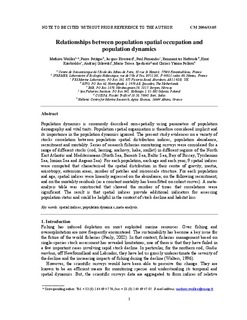| dc.description.abstract | Population dynamics is commonly described non-spatially using parameters of population
demography and vital traits. Population spatial organisation is therefore considered implicit and
its importance in the population dynamics ignored. The present study evidences on a variety of
stocks correlation between population spatial distribution indices, population abundance,
recruitment and mortality. Series of research fisheries monitoring surveys were considered for a
range of different stocks (cod, herring, anchovy, hake, mullet) in different regions of the North
East Atlantic and Mediterranean (North Sea, Barents Sea, Baltic Sea, Bay of Biscay, Tyrrhenian
Sea, Ionian Sea and Aegean Sea). For each population, each age and each year, 9 spatial indices
were computed that characterised the spatial distribution in their centre of gravity, inertia,
anisotropy, extension areas, number of patches and microscale structure. For each population
and age, spatial indices were linearly regressed on the abundance, on the following recruitment,
and on the mortality residuals (as a constant mortality has been fitted on cohort curves). A metaanalysis
table was constructed that showed the number of times that correlations were
significant. The result is that spatial indices provide additional indicators for assessing
population status and could be helpful in the context of stock decline and habitat loss.
Key words: spatial indices; population dynamics, meta-analysis. | no_NO |
